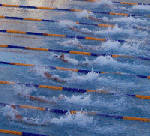
|

|

|

|

|
|
LACTATE TESTING FOR SWIM COACHES - WHY USE IT?
Lactate testing is the only practical way to find essential information
about your swimmer!
The really, really useful information of lactate testing shows you the
changing relationship between effort and speed - more effort means more
lactate so, at the low intensities the speed increases faster than the
lactate; at the higher intensities, the lactate changes faster than the speed.
It's the same as working a little harder for a big reward, then having to work
much, much harder for further, smaller and smaller rewards. The thing which
keeps you going is that the rewards are incremental - no matter how much
smaller they get, the total just keeps getting bigger and you swim
faster.
With the Accusport Portable Lactate Analyzer cost, time and effort are no
longer the deterrent or constraint they once were. Samples are easy to take
and analyze, and regular tests cost no more than a few dollars for each
swimmer.
|

|
TESTING IS NOT NEW
Coaches have always tested their swimmers.
Of course, time and distance are monitored and tested virtually every
repetition and, in day-to-day practice, heart-rate monitoring is regularly and
frequently used. Stroke-rate and stroke-count are measured; sit-ups and chins
are counted; the number of bench-presses with a particular weight are counted
and recorded; sleep-patterns, degree of fatigue, muscle-soreness and mood are
assessed to alleviate the chances of "over-training". Lactate testing will
give you information which can be more valuable than any of these regularly
used tests but its' acceptance has been slow, especially in North America.
The perceived connection between testing and the, now-admitted, doping program
of East Germany is undoubtedly responsible for much of the antagonism towards
testing but, while the East German swimming program relied on lactate results
to determine subsequent training regimes and relied on doping to facilitate
those regimes, the two are not inextricably bound together except in the minds
of some coaches. In fact, we could say, that without doping it is even more
important for the coach to know the effect of training and be able to measure
it accurately.
These pages will explain the testing procedures which, if used
systematically, will provide that information which is even more valuable than
any of the tests you currently use.
|
This page covers :
Lactate versus heart-rate monitoring
The three vital components of sporting performance©
Other tests - lactate clearance, alactic efforts, and training effects;
Education
|

|
THE RACE MODEL
A lactate race model can be described thus :
Start and early metres - decelerate from the dive to race pace and hold with as little lactic acid production as possible.
Mid-race part 1 - swim as fast as possible using aerobic metabolism.
Mid-race part 2 . - continue swimming fast, even accelerate, producing increased levels of lactic acid.
End-part - accelerate, or decelerate as little as possible, under stress and fatigue, tolerating the extended time the muscles have to operate under highly acidic conditions.
|
Each of these portions of a race is addressed in a systematic training regime. Each of them can be tested to ascertain the current status and a training program designed based on the results. The subsequent training effect can be gauged by re-testing.
HEART-RATE MONITORING CANNOT DO THIS: Lactate information shows you
the oxygen use where it counts - in the muscles, at the cellular level.
Heart-rate monitoring, although a very simple and very useful tool, does not,
and cannot, do this. Heart-rate monitoring shows you the oxygen demand
by the muscles; it does not show the oxygen use. Oxygen use, not oxygen
demand is a limiting factor in swimming fastest.
THE THREE VITAL COMPONENTS OF SPORTING PERFORMANCE©: With proper test procedures and simple computer analysis, information can be gained which encapsulates all the components of successful performance in swimming. For all Olympic swimming events, the physiological components which ensure success are :
|

|
1. Endurance; the velocity during, predominantly, aerobic work.
2. The lactic acid value at Maximum effort.
3. The Power-relationship between these first two components.
|
AEROBICIn general coaching terms, aerobic work means endurance or
stamina swims. If the aerobic component is measured at a level of intensity
suitably reflecting the aerobic requirements of the swimmer's event, then
an accurate indication of the endurance capability can be shown.
Many programs have used 4mM of lactate as their standardized measure of
aerobic intensity. If you choose a very low, or very high intensity, your
results will not reflect the endurance capabilities accurately, so 4mM is a
good choice and enables you to compare your results with those of many other
programs. For sports other than swimming, 4mM may be inappropriate but, for
us, its ok, although you can choose any level you wish - just be
consistent.
Scientists tend to measure the velocity, or speed, at 4mM, but coaches are
comfortable talking about times rather than velocities, so the time at
lactate 4mM is more meaningful. This is abbreviated to tV4. Different
levels would be tV2 or tV3, etc.
Measures of endurance
Measuring endurance capabilities in swimmers is one of the easiest coaching tasks.
Any Standard Test Set (STS) or Timed-distance Swim will provide information about the endurance capabilities of the swimmer. You will know how fast they are but, even if they give a maximum effort, you will not know how much energy they have used to produce the speed. If they do not give maximum effort you will know very little indeed. Lactate testing during one of these sets will tell you the effort precisely, even if they swim sub-maximally.
MAXIMUM LACTATE VALUE Lactic acid moving out of the muscles becomes lactate when it enters the bloodstream. As swimmers apply more effort to swim faster, we can measure more lactate. If they train to produce very high amounts of lactate and control their application of power, they will be able to swim even faster. The highest lactate result of a test is, therefore, a very important parameter - it corresponds to the maximum speed. It is abbreviated to LaMax.
|
THE RELATIONSHIP BETWEEN tV4 AND LaMAXIn a nutshell, this relationship describes the swimmer's ability to increase speed through the application of power and to apply power throughout the range of intensity. I always read that sentence more than once - it's that important.
It is not possible to measure this swimming-specific power on land.
The relationship is dependent on factors internal to the swimmer. These include :
fibre-typing,
muscle cross-sectional area,
total fibre surface-area
|

|
This component is the one most often ignored, misunderstood, or misinterpreted by both exercise physiologists and coaches. It is the third vital component of sporting success and can make just as much difference to the race performance as the tV4 and much more difference than LaMax. By measuring those three vital components we can see a virtual picture of the swimmer.
Metabolic triumverate.
All three vital components are inter-related. For example, training which is designed to produce changes in aerobic conditioning will, necessarily, also change the LaMax and the relationship between aerobic conditioning and maximum lactate. The only way you can be aware of the degree of change is by lactate testing. The only way you can decide which way to structure your program to produce change, is by lactate testing. All three components are integral to sporting performance; you cannot have one or two of them - all three are omni-present and successful performance demands a correct balance between the three.
The only way you can accurately measure any of them is by lactate testing.
OTHER TESTS
Almost every training parameter can be monitored, tested and evaluated using lactate analysis. In addition to the three vital components of sporting performance©, the most important are:
Lactate clearance
The clearance of lactate from the blood indicates the clearance of lactic acid in the muscles. The faster this occurs, the faster the muscle can get on with more work! Slow or delayed lactate clearance is fast becoming the recognized indicator of over-training and the degree of clearance over time can be used to prescribe effective swim-down protocols.
|

|
Alactic energy replacement
Short, high-intensity sprints of, maybe 10-15 meters, use energy-supply systems which are alactic - literally, "without lactic acid".
If you design a high-intensity set where you expect little lactic acid production, then there should be little lactate appearing in the blood. If a low test value is returned, this confirms that the energy supply used was alactic.
|
TRAINING EFFECT
During any training set, three entirely different things can coincide:
The effect the coach intended when the set was written.
The effect the coach and swimmer assess, after the effort, by observation, experience, perception and "feel".
The effect the set actually imparts on the muscle cells.
Swimmers usually follow coaches' training instructions fairly closely and good coaches can "eyeball" the swimmers' effort and status very accurately. However, swimmers can improve or deteriorate to a large degree over a few weeks or even days. You can never be sure of the effect of any particular training set unless you test.
The only method of ascertaining the actual intensity and effect of a training set, is to test.
|

|
EDUCATION
Some of the great swimmers have been described as: "knowing more about physiology than most coaches."
|
Deliberate training
This comment was not a light-hearted dig at coaches but a recognition that swimmers
have to understand the training processes in order to train
deliberately; that is, with full consciousness and feedback. Lactate testing
can act as a superb educational tool, giving swimmers accurate information
about what is actually happening in their muscles when they train, and
enabling them to understand the effects of different sets and the importance
of the control of the relationships between the various training
parameters.
Testing is the only way to discover some of this information and, where other methods are available, lactate testing is the most accurate, efficient and effective way.
|

|
WHICH SWIMMERS BENEFIT MOST FROM TESTING?
As usual, it depends.
It depends on you. Whether you deal with young, developing age-groupers or mature, Olympic Champions, the benefits to be gained from lactate tests lie in your hands. A well-designed, consistent, systematically administered testing program will bring benefits to any age or standard of swimmer.

|
|
Why |
How |
Interpret |
Lactate.com
Home | Swimming
Core | Glossary
Questions? Please email info at lactate dot com
Published originnally March 29, 1998. All contents © Sports Resource
Group, Inc.
|








